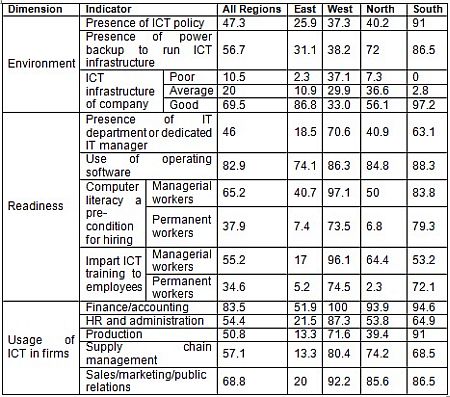Government of India’s ‘Digital India’ programme seeks to transform the country into a digitally-empowered society and knowledge economy. This column presents region-wise findings of a perception-based survey of the e-readiness of firms. While firms in west India seem to be more e-ready than those in other regions, there is tremendous scope across all firms to increase the use of information and communications technology in business activities to improve productivity.
The National Council of Applied Economic Research (NCAER) together with the Department of Electronics and Information Technology (DeitY) has assessed the e-readiness of states and union territories (UTs) of India six times since 2003 (Department of Information Technology (DIT) and NCAER, 2003, 2004, 2006, 2007, 2010 and 2014)1. This body of work defined e-readiness as the ability to pursue value-creation opportunities for inclusive economic development facilitated by information and communications technology (ICT). Although conceptually similar to its international cousins, the indicators used are more relevant to India (Venkatesan et al. 2012).
The NCAER e-Readiness Framework considers three stakeholder groups in the development and use of ICT - individuals, businesses, and government. The broad framework of analysis has three major components - environment, readiness, and usage. Environment analysis includes the market, political, regulatory, and infrastructure environment. Readiness assesses the ability of stakeholders to use and produce ICT/ICT-enabled goods and services. Lastly, given the environment and readiness, usage covers the extent to which stakeholders actually use ICT-enabled goods and services.
Economic intuition would say that businesses would be ahead of individuals and the government in creating a conducive environment for ICT and hiring or training a labour force that knows how to use and produce ICT/ICT-enabled goods and services. However, this information is not always readily available or is only available at significant lags. Therefore, to further our understanding of business e-readiness across the country, we conducted a perception-based analysis of business e-readiness under the Business Expectations Survey (BES) framework2.
Along with the standard assessment of business sentiments conducted every quarter, NCAER also assesses other aspects of business. The BES conducted in September 2016 included a survey about ICT readiness of firms. In this column, we present ICT assessment across regions based on the outcome of the survey. Following the NCAER and DeitY framework, the Business e-Readiness Survey has three sections - environment, readiness, and usage. The first section asks questions about firms’ ICT environment. The second section assesses firms’ readiness in terms of capacity formation and skill-building in ICT, and their presence online. The third section asks about the usage of ICT in various business activities and the benefits accruing to firms. Table 1 below presents the region-wise results.
Table 1. ICT readiness of firms region-wise, October 2016 (% of respondents)
 Note: The survey asked firms to rate their ICT infrastructure and that of their area from one to five (five being the best). Ranks one and two are clubbed in the category “poor”. Rank three is categorised as “average”, and ranks four and five are categorised as “good”.
Note: The survey asked firms to rate their ICT infrastructure and that of their area from one to five (five being the best). Ranks one and two are clubbed in the category “poor”. Rank three is categorised as “average”, and ranks four and five are categorised as “good”. Source: NCAER (2016).
ICT environment of firms
In this section, we assess the presence of a well-established ICT policy and available infrastructure within the firms.
- Presence of ICT policy provides dynamism to the ICT infrastructure of companies. Overall, 47.3% of surveyed firms have their own ICT policy with the southern region leading the way where as much as 91% of firms have ICT policy.
- Continuous electricity supply is a prerequisite for ICT implementation and power backup serves the purpose of overcoming any deficit in that infrastructure. Overall, 56.7% of firms have power backup to support ICT infrastructure, with higher presence of power backup in the northern and southern regions versus the eastern and western regions. There are two possible explanations for this – one is the availability of power in the region3, and second is the usage of electricity in activities.
- As much as 69.5% of firms are satisfied with their own ICT infrastructure. In the South as much as 97.2% of firms rate ICT infrastructure as ‘good’ in contrast to only 33% in the West. In the West, as many as 37.1% respondents view their ICT infrastructure as poor. The North also performed poorly relative to the South and the East.
Overall, the perception survey indicates that the ICT environment of the firms in the southern region outperforms other regions.
ICT readiness of firms
In this category, we assess the preparedness of firms in terms of being able to use ICT. Questions were asked about the presence of either IT department or IT manager; use of various operating software like MS Office, Enterprise Resource Planning (ERP) etc.; if computer literacy is a prerequisite for hiring at various levels; and if ICT training is imparted to employees at regular intervals.
- Overall, 46% of firms have either an IT department or a dedicated IT manager. Presence of this is maximum in the West and minimum in the East.
- As many as 82.9% of firms use one or other operating system and there is not much variation across regions.
- Regarding computer literacy being a prerequisite for hiring by firms, numbers are significant in case of hiring of workers at the managerial level with 65.2% of firms saying that it is the case. The figures are high in all regions; however, West and South stand out.
- Regarding imparting ICT training to employees of various types, results are an exact replication of computer literacy being a prerequisite for hiring, with firms in the West and South doing better as compared to the East and the North.
Despite not having the best ICT environment, the western region exhibits a higher degree of readiness with dedicated IT manager/department, use of software, hiring computer literate managers, and imparting ICT training to employees.
ICT usage of firms
In this section, we see whether firms are actually using ICT in their various activities. The survey asked firms whether they are using ICT in the various activities and how beneficial it is for them4.
- Majority of firms use ICT in their finance and accounting operations (83.5%). In the West this number is as high as 100% and in the East this is 51.9%. Also, in this activity the highest percentage of firms gets significant benefit (82.7%) from ICT use.
- 68.8 per cent of firms use ICT in sales, marketing and public relations. Here, 76.8% of those who use ICT get significant benefits from its use.
- Percentage of firms using ICT in HR and administration, production, and supply chain management stand at 54.4%, 50.8% and 57.1%, respectively. ICT use in all these gives significant benefits to 80.3%, 71.3% and 74.1% of respondents, respectively.
The firms in the western region are showing higher degree of usage and also perceive the most benefit from it. The firms in the eastern region seem to be lagging behind.
Conclusions
Overall, it would seem that the firms in the western region are more e-ready versus other regions. ICT is important for firms to improve their productivity both for ICT-producing sectors and capital deepening in ICT-using sectors (Biagi 2013). The perceptions survey indicates that there is tremendous scope for firms to use ICT in their various activities to improve their productivity. The effectiveness of various key government programmes such as Digital India and Make in India, may be enhanced if ICT is adopted by firms in all regions of the country. This survey also indicates that there is an acute need to assess business e-readiness of firms on a more continuous basis and in a comprehensive manner, which may give key policy insights to all stakeholders.
iViews are personal and do not necessarily represent those of the organisation that the authors are affiliated with. The authors are grateful to R. Venkatesan for his insights and guidance.
Notes:
- DeitY was renamed as Ministry of Electronics and Information Technology. DIT is a part of the Ministry.
- The NCAER has been conducting the Business Expectations Survey (BES) every quarter since 1991. It tracks the business sentiments of over 500 Indian companies to compute the composite Business Confidence Index (BCI). The survey elicits responses from firms/industries spread across regions (Delhi NCR representing the North, Mumbai and Pune the West, Kolkata the East, and Bengaluru and Chennai the South), industry sector (consumer durables, consumer non-durables, intermediate goods, capital goods and services), ownership type (public sector, private and public limited, partnership, and multinational corporations), and firm size (annual turnover less than Rs. 10 million, 10-100 million, 100 million–1 billion, 1-5 billion, and over 5 billion). The sample is drawn randomly from various sources and from a list of industries in each city.
- Part of the explanation for not having power backup could be that there is adequate power supply in the region. The previous version of the same survey carried out in September 2015 had asked about the percentage of (working) time the firm got electricity from the power supplier. 89.4 per cent of the firms had responded that electricity was available for more than 75% of the time. The eastern and western regions had performed relatively better than the southern and northern regions.
- This has not been reported in Table 1.
Further Reading
- Biagi, F (2013), ‘ICT and Productivity: A Review of Literature’, Institute for Prospective Technological Studies Digital Economy Working Paper 2013/09.
- DIT, NCAER and Indian Market Research Bureau (2003), ‘INDIA: e-Readiness Assessment. For States/Union Territories and Central Ministries/Departments 2003’, NCAER, New Delhi.
- DIT and NCAER (2004), ‘INDIA: e-Readiness Assessment. For States/Union Territories 2004’, NCAER, New Delhi.
- DIT and NCAER (2007), ‘INDIA: e-Readiness Assessment. For States/Union Territories 2005’, NCAER, New Delhi.
- DIT and NCAER (2006), ‘INDIA: e-Readiness Assessment. For States/Union Territories 2006’, NCAER, New Delhi. Available here.
- DIT and NCAER (2010), ‘INDIA: e-Readiness Assessment. For States/Union Territories 2008’, NCAER, New Delhi. Available here.
- Department of Electronics and Information Technology (DeITY) and NCAER (2014), ‘INDIA: e-Readiness Assessment. For States/Union Territories 2011–12’, NCAER, New Delhi.
- Venkatesan, R, W Wadhwa, S Sen, B Bhandari and S Ramakrishnan (2012), ‘e-Development Index’, NCAER Discussion Paper, New Delhi.
- NCAER (2016), ‘NCAER Index of Business Confidence Survey of Business Expectations in India. October 2016’, NCAER, New Delhi.




 24 January, 2017
24 January, 2017 





Comments will be held for moderation. Your contact information will not be made public.